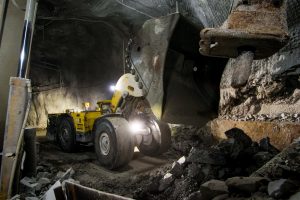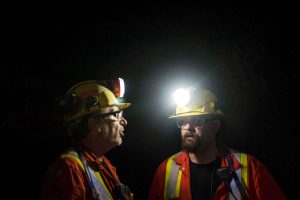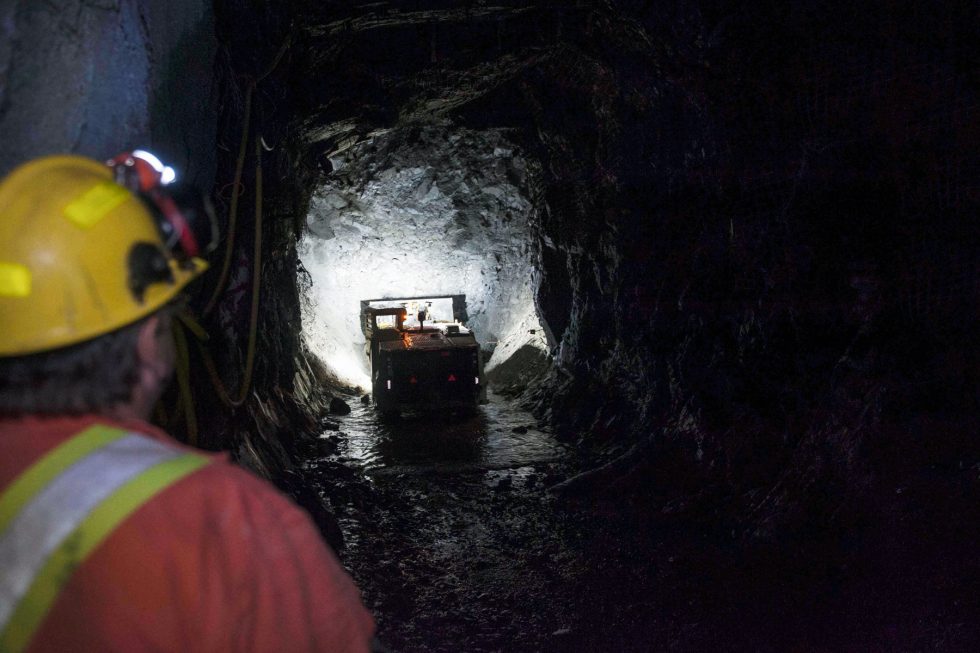Operator Wayne Locht trams his Scooptram ST14 loader to the automation zone, passing white Wi-Fi boxes mounted on the access walls. He stops short of the first ?light curtain?, a laseractuated barrier marking the zone?s boundary. Crossing a light curtain will trip a shutdown of the level and alarm those at the surface.

Equipment at Hemlo is tagged to display its location in the mine with Mobilaris real-time tracking software. The same Mobilaris technology is planned for miners? hard hats by the end of 2018. Exiting the cab, Locht says: ?We still personally walk the area to make sure no one is in the zone.? Reassured the zone is clear, he takes an electronic ?key? from a safety box near the light curtain. ?This key gives the rig permission to enter. It connects the rig to the automation area so that the safety system knows that the rig is in the area.? He inserts the key into a socket beneath his operator?s seat. The red status light on the pole turns to flashing yellow. Locht may proceed to the second light curtain.

Parking the rig between the first laser barrier and the next, Locht sets the brake and flips a switch on the operator console from manual to remote control. He leaves the cabin a final time, removing the key from below the seat. Plugging it back into the safety box, it rearms the first light barrier and mutes the second. The level-status light turns green.
Locht radios the operator waiting at the control room operator station on the surface 1.4 kilometers above. The rig is now in his hands and Locht catches a 40-minute ride to the surface.
Autonomous tramming and teleremote operation are the most recent addition to an automation program at Barrick Gold Corporation?s Hemlo openstoping operation near Marathon, Ontario, that began with an autonomous truck circuit in 2007. It is accelerating its automation program with a five-year plan after a year-long search for a solution offering the lowest cost, quickest implementation and solid product support.
?We studied all available technology. We had conferences with manufacturers and visited their facilities. We toured operations where their equipment was at work,? says Patrick Marshall, Manager Automation Projects.
?We believe the Epiroc package featured the product support we wanted, had the best integration capability for our multivendor operation, had the right pricing model and, in general, was the best fit for our needs.?
Barrick preferred to use Cisco for wireless infrastructure. ?Commonality is important to us,? Marshall explains. ?Epiroc?s system is easily adaptable for use with third-party wireless systems.?
For Hemlo, safety is the greatest benefit of the high-tech Scooptram ST14. Combining autonomous tramming with teleremote operation also increases productivity.
? Automation and tele remote control get workers away from the operating environment to an office on the surface ? the ultimate in safe operation,? says Mine Superintendent Jon Laird. ?And since it continuously mucks from stopes at a steady rate even through shift changes, it eliminates having to move operators to it every shift.?
Laird says the 14-tonne-capacity Scooptram loader is ?so efficient it threatens to outpace crushing operations at the ore pass.? He smiles broadly when he adds: ?Overproduction is a good problem to have.?
One solution under discussion is creating additional ore passes to give one crushing operation time to clear ore between dumps. The Scooptram loader can easily learn multiple routes and alternate between them. Other systems Hemlo looked at took up to a full shift for the route-learning process.
Graham Hanson, Innovation and Technology Manager, who heads up teleremote operations at Hemlo, says, ?This rig, you just run the route to learn it and it?s ready to go.?
Trevor Kelly, Barrick Technical Excellence Director, says implementation requires faith and patience. ?While we are seeing what we expect in general, we can?t precisely measure overall results for some time yet. How much are we saving? How much more productive and efficient are we??
and patience. ?While we are seeing what we expect in general, we can?t precisely measure overall results for some time yet. How much are we saving? How much more productive and efficient are we??
Certiq, the telematics system installed on the Scooptram, will be essential for tracking, documenting and analyzing operational data to learn how much they gain from their investment in automation.
However, it isn?t all about numbers. Introducing advanced technology raises concerns about job security. Hemlo has actually added personnel to build and maintain its Wi-Fi infrastructure. And automation has opened paths for other employees to more fully realize their potential with expanded skillsets, achieving at higher levels in an improved working environment.

Scooptram operator Wayne Locht returns to the surface to complete his shift from the Automation Room. Its size and appearance are that of a small classroom. Windows span the full length of the far wall, offering a panoramic view of the Ontario landscape.
There is an electronics cabinet beside a table with an array of computer monitors behind a single control pad. Locht crosses to the desk to see how things have gone for the operator who has monitored the Scooptram ST14 since Locht left it in the automation zone. Then he?s off to the locker room just down the hall to get out of his underground gear. He returns minutes later showered and in his street clothes, takes his seat in the padded office chair and rolls up closer to study live footage from the Scooptram. It?s pulling up to the ore pass with a full bucket. Mucking is not yet an automated feature, so Locht takes the joysticks in hand.
Until the rig is refueled, after approximately 16 hours, no human being will visit the rig or enter the automation zone. Teleremote operators will monitor its routine, taking control only during loading and dumping operations.
Barrick?s next step is finishing the wireless infrastructure throughout the Hemlo mine, expanding the automation zones, and getting more loaders. A single operator will run more than one machine from a control station, and the mine will have more than one station. Operators at any station will be able to control any of the automated Scooptram loaders, anywhere in the mine.
Patrick Marshall says, ?Today, we?re connected. Tomorrow we?ll have optimized fleet management. In the near future, we?ll achieve our ultimate goal ? fully autonomous mining underground executed by our operators from the surface.?
5 keys to success
Mobilaris real-time location tracking
Mine-wide use of Mobilaris Mining Intelligence not only gives Hemlo real-time equipment tracking, but the precise location of each person underground ? a vital
advantage in case of an emergency.
Designed with operators in mind
Operators report high satisfaction with the ergonomics, power, comfort and features of the Scooptram ST14 loader. Transitioning to teleremote and autonomous operation is quick and easy to learn.
Capacity and speed boost productivity
The Scooptram ST14 loader with 14-tonne bucket capacity gives fast, fully loaded tramming speeds rated up to 29.5 km/h on level ground and up to 4.8 km/h up a 25 percent grade.
Safer, more comfortable environment
Automated loadhaul-dump operation reduces ventilation and climate control requirements for deep mining operations and moves operators to a safer, more comfortable environment than is possible with line-of-sight radio remote control.
Multi-use Wi-Fi
Wireless infrastructure for autonomous operation also enables live access to performance data and provides minewide network access for location tracking and communication capabilities like mid-interval reporting.
Epiroc operated under the trademark “Atlas Copco” prior to January 1, 2018.





Here:
Us: